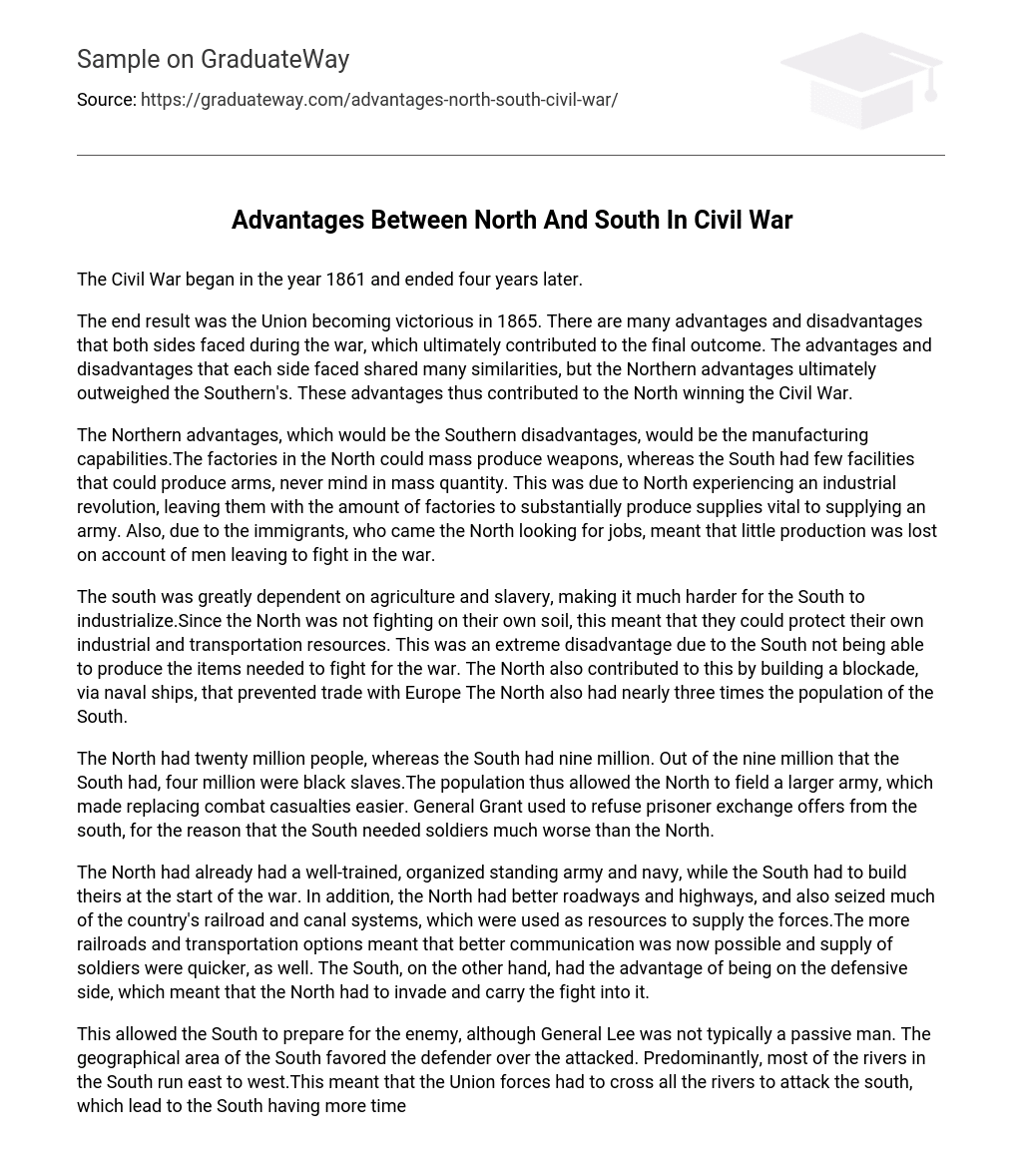The Civil War began in 1861 and concluded within a span of four years.
Despite facing similar challenges, the Union emerged victorious in 1865 due to a combination of advantages and disadvantages for both sides during the Civil War. Ultimately, it was the Northern advantages that led to their triumph.
The North, unlike the South, had numerous factories that could produce weapons on a large scale due to their industrial revolution. This advantage arose from the creation of efficient factories capable of producing essential supplies for an army. In contrast, the South had limited manufacturing capabilities and only a few facilities capable of manufacturing arms in significant quantities. The North also benefited from an influx of immigrants seeking employment opportunities, which helped mitigate any production decline caused by men leaving to participate in the war.
The South, heavily dependent on agriculture and slavery, faced significant challenges during the industrialization process. Unlike the North, which protected its industrial and transportation assets as it was not involved in a war on its own territory, the South struggled to produce essential materials for warfare. This disadvantage was worsened by a naval blockade imposed by the North to disrupt trade with Europe. Furthermore, the Northern population was nearly three times larger than that of the South.
The North had a population of 20 million people, while the South had 9 million individuals. Among the Southern population, there were 4 million African American slaves. This population disparity gave the North an advantage in terms of having a larger army and easier replacement of lost soldiers during battles. General Grant rejected prisoner exchange offers from the South due to their requirement for more soldiers than the North.
The North had an established, disciplined army and navy, while the South had to create theirs when the war began. Furthermore, the North possessed superior roads and highways and took control of a significant portion of the country’s railroad and canal networks, which served as valuable resources for supplying their forces. The increased number of railroads and transportation options facilitated improved communication and faster delivery of soldiers. Conversely, the South benefited from being on the defensive, forcing the North to initiate invasions into its territory.
Despite General Lee usually not being a passive man, the South was able to prepare for the enemy due to the geographical advantage it possessed. The South’s terrain favored defenders since most of its rivers, flowing east to west, required the Union forces to cross them in order to attack. Consequently, this granted the South more time to launch counterattacks.
Essentially, the Union was required to conquer all of the Southern territory in order to claim victory because the confederacy was defending itself. The South possessed a significant number of devoted soldiers who were committed to protecting their land and seeking victory. On the other hand, the North had to engage in combat in order to defend and maintain the Union, as they believed it was of utmost importance.
The North, including the Border States totaling a large population of Southern sympathizers, consistently faced challenges in maintaining their support for the war. Moreover, compared to the North, the Southern population displayed greater unity. The reasons for engaging in the war in the North were frequently subject to debate.
The majority of top leaders hail from the South and when the South seceded from the Union, the soldiers went with their respective states. The military leadership of the South comprised a significant number of veterans from the Mexican War. During the Civil War, President Lincoln made efforts to find capable generals, but many argue that Grant was the only competent general in the North, contrasting with the South which had inferior leadership.
The southern soldiers were lucky to have skilled officers like Generals Lee, Stonewall Jackson, Longstreet, Forest, and Stuart who had expertise in combat tactics and effectively handled difficult situations. Additionally, the average Southerner had hunting experience for food, enabling them to sustain themselves and proficiently use firearms. In contrast, a significant number of Northerners originated from urban areas where they had no prior exposure to rifles prior to the war.
Initially, the South had an advantage in terms of soldiers who were more familiar with outdoor life. However, due to regional disparities in strengths and weaknesses, winning the Civil War posed great difficulty. The war endured for four years and caused numerous casualties. Ultimately, the North’s greater level of industrialization provided them with a competitive edge.
This demonstrates that Lee’s superior generalship during the war, but the loss of Stonewall Jackson is where the Civil War began to crumble for Lee. The North, with its numerous troops, effectively defeated Lee and preserved the Union.





